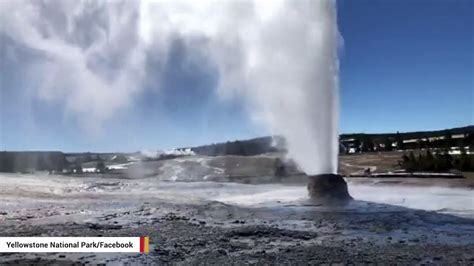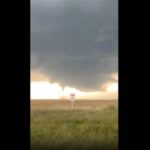
A recent eruption of the Giant Geyser at Yellowstone National Park, captured on camera, has drawn attention from park visitors and scientists alike. The geyser, known for its infrequent but powerful eruptions, put on a stunning display, reaching significant heights and duration, reminding onlookers of the park’s dynamic geothermal activity.
Giant Geyser, located in the Upper Geyser Basin, part of the greater Old Faithful area, erupted spectacularly, as reported by witnesses and captured in photographs and videos. The eruption, which occurred recently, lasted for an extended period, showcasing the geyser’s impressive power. According to Yellowstone National Park’s official website, Giant Geyser is classified as an “infrequent” geyser, meaning that its eruptions are not as predictable as those of Old Faithful. This unpredictability makes each eruption a unique and highly anticipated event.
The recent activity of Giant Geyser is part of the ongoing geothermal processes that characterize Yellowstone National Park. The park, which sits atop one of the world’s largest active volcanoes, is home to more than 10,000 hydrothermal features, including geysers, hot springs, mud pots, and fumaroles. These features are powered by the heat from the Yellowstone hotspot, a vast reservoir of magma beneath the surface.
While the eruption of Giant Geyser is a natural phenomenon and not indicative of an impending volcanic eruption, it serves as a reminder of the powerful geological forces at play within Yellowstone. The park’s geysers are sensitive to changes in subsurface conditions, such as variations in water levels and pressure, and their behavior can provide valuable insights into the complex dynamics of the Yellowstone volcanic system.
Geothermal activity in Yellowstone is closely monitored by scientists from the Yellowstone Volcano Observatory (YVO), a collaborative partnership among the U.S. Geological Survey (USGS), Yellowstone National Park, and several universities. The YVO tracks the park’s geysers, hot springs, and other hydrothermal features, as well as monitoring seismic activity, ground deformation, and gas emissions. This comprehensive monitoring network allows scientists to detect any changes that could indicate potential volcanic unrest.
The eruption of Giant Geyser also highlights the importance of responsible tourism and visitor safety in Yellowstone National Park. Visitors are encouraged to stay on designated trails and boardwalks, and to maintain a safe distance from thermal features. The water in hot springs and geysers can reach scalding temperatures, and the ground around these features can be unstable. By following park guidelines, visitors can protect themselves and help preserve the park’s fragile environment.
Yellowstone National Park is a natural laboratory for studying geothermal processes and volcanic activity. The park’s geysers, hot springs, and other hydrothermal features provide scientists with valuable opportunities to learn about the Earth’s internal heat and the dynamics of volcanic systems. The eruption of Giant Geyser is a reminder of the ongoing geological activity that shapes Yellowstone and the importance of continued monitoring and research.
Giant Geyser, known for its irregular and often spectacular eruptions, differentiates itself from the predictable Old Faithful, drawing enthusiasts hoping to witness its powerful displays. The geyser’s activity is influenced by complex subsurface conditions, making each eruption unique in terms of height, duration, and interval. According to park rangers and geyser gazers, the recent eruption was particularly noteworthy for its intensity and longevity, adding to the geyser’s reputation as one of Yellowstone’s most impressive geothermal features.
The eruption of Giant Geyser provides valuable insights into the park’s hydrothermal system. The heat source for Yellowstone’s geothermal features is the Yellowstone hotspot, a plume of magma located beneath the Earth’s crust. This hotspot provides the energy that drives the park’s geysers, hot springs, and other thermal features. Water seeps into the ground and is heated by the magma below. The heated water rises through cracks and fissures in the rock, eventually erupting at the surface in the form of geysers and hot springs.
The behavior of geysers is influenced by a variety of factors, including the amount of water available, the temperature of the water, and the geometry of the underground plumbing system. Geysers erupt when the pressure of the superheated water becomes too great, causing it to explosively release as steam and water. The eruption of Giant Geyser is a result of this complex interplay of factors, and its recent activity provides scientists with valuable data for understanding the park’s hydrothermal system.
The Yellowstone Volcano Observatory (YVO) continuously monitors the park’s geothermal activity. The YVO uses a variety of tools and techniques to track changes in the park’s geysers, hot springs, and other thermal features. These include seismic monitoring, ground deformation measurements, gas emission measurements, and thermal infrared imaging. By monitoring these parameters, the YVO can detect any changes that could indicate potential volcanic unrest.
While the eruption of Giant Geyser is not indicative of an impending volcanic eruption, it serves as a reminder of the park’s dynamic geological environment. Yellowstone is one of the most seismically active areas in the United States, and the park experiences thousands of earthquakes each year. Most of these earthquakes are small and go unnoticed by visitors, but larger earthquakes can occur. The YVO monitors seismic activity in the park to assess the risk of volcanic eruptions and other geological hazards.
Yellowstone National Park is a popular destination for tourists from around the world. The park’s geysers, hot springs, and other thermal features are a major attraction, and visitors flock to the park to witness these natural wonders. The eruption of Giant Geyser is a reminder of the park’s beauty and power, and it underscores the importance of protecting this unique and valuable resource.
Visitors to Yellowstone National Park are encouraged to follow park guidelines and to stay on designated trails and boardwalks. The water in hot springs and geysers can reach scalding temperatures, and the ground around these features can be unstable. By following park guidelines, visitors can protect themselves and help preserve the park’s fragile environment. Yellowstone National Park is a treasure to be appreciated and protected for future generations.
Extended Details and Analysis:
The eruption of the Giant Geyser is part of a broader pattern of dynamic geothermal activity in Yellowstone National Park. To fully understand the significance of this event, it is essential to delve into the geological context of the region, the characteristics of Giant Geyser, the monitoring efforts undertaken by the Yellowstone Volcano Observatory (YVO), and the implications for visitor safety and park management.
Geological Context:
Yellowstone National Park is situated atop the Yellowstone Caldera, a massive volcanic depression formed by several cataclysmic eruptions over the past 2.1 million years. The most recent major eruption occurred approximately 640,000 years ago, creating the present-day caldera. Beneath the surface lies a vast magma reservoir, which serves as the heat source for the park’s numerous hydrothermal features.
The Yellowstone hotspot is a plume of hot mantle material that rises beneath the North American Plate. As the plate moves over the hotspot, it creates a series of volcanic centers, with Yellowstone being the most recent. The heat from the hotspot melts the surrounding rock, creating magma that accumulates in a large reservoir beneath the surface. This magma reservoir is the engine that drives Yellowstone’s geothermal activity.
The hydrothermal features in Yellowstone are a direct result of the heat and water interacting beneath the surface. Water seeps into the ground through cracks and fissures in the rock and is heated by the magma below. The heated water becomes buoyant and rises towards the surface. As it rises, it dissolves minerals from the surrounding rock, creating a complex mixture of hot water, steam, and dissolved chemicals.
Geysers are a special type of hydrothermal feature that erupts periodically, sending a plume of hot water and steam into the air. The eruption of a geyser is caused by the buildup of pressure in the underground plumbing system. As the water is heated, it expands and creates steam. The steam becomes trapped in the narrow conduits leading to the surface, building up pressure. When the pressure exceeds the strength of the surrounding rock, the steam and water are released in a powerful eruption.
Giant Geyser: Characteristics and Behavior:
Giant Geyser is located in the Upper Geyser Basin, near Old Faithful. It is classified as an “infrequent” geyser because its eruptions are not as predictable as those of Old Faithful. Giant Geyser has a complex plumbing system, which contributes to its irregular eruption pattern.
Eruptions of Giant Geyser can reach heights of over 250 feet (76 meters) and last for several hours. The geyser’s eruption is characterized by a series of bursts of water and steam, followed by a period of sustained activity. During an eruption, Giant Geyser can release thousands of gallons of water and steam into the air.
The interval between eruptions of Giant Geyser can vary from several days to several months. The geyser’s eruption pattern is influenced by a variety of factors, including the amount of water available, the temperature of the water, and the geometry of the underground plumbing system.
The recent eruption of Giant Geyser was notable for its intensity and duration. Witnesses reported that the eruption reached significant heights and lasted for an extended period, making it one of the most impressive displays in recent years.
Yellowstone Volcano Observatory (YVO): Monitoring Efforts:
The Yellowstone Volcano Observatory (YVO) is a collaborative partnership among the U.S. Geological Survey (USGS), Yellowstone National Park, and several universities. The YVO is responsible for monitoring volcanic and hydrothermal activity in Yellowstone National Park and assessing the risk of volcanic eruptions.
The YVO uses a variety of tools and techniques to monitor Yellowstone’s geothermal features. These include:
- Seismic monitoring: The YVO operates a network of seismometers that record earthquakes in and around Yellowstone National Park. Earthquakes can be caused by the movement of magma beneath the surface, and changes in seismic activity can indicate potential volcanic unrest.
- Ground deformation measurements: The YVO uses GPS and satellite radar to measure changes in the elevation of the ground surface. Ground deformation can be caused by the inflation or deflation of the magma reservoir beneath the surface, and changes in ground deformation can indicate potential volcanic unrest.
- Gas emission measurements: The YVO measures the amount of volcanic gases, such as carbon dioxide and sulfur dioxide, that are released from Yellowstone’s hydrothermal features. Changes in gas emissions can indicate changes in the activity of the magma reservoir.
- Thermal infrared imaging: The YVO uses thermal infrared cameras to measure the temperature of Yellowstone’s hot springs and geysers. Changes in temperature can indicate changes in the hydrothermal system.
The YVO closely monitors the behavior of Giant Geyser and other hydrothermal features in Yellowstone National Park. The data collected by the YVO is used to assess the risk of volcanic eruptions and to provide timely warnings to park visitors and managers.
Implications for Visitor Safety and Park Management:
Yellowstone National Park is a popular destination for tourists from around the world. The park’s geysers, hot springs, and other thermal features are a major attraction, and millions of people visit the park each year.
The eruption of Giant Geyser is a reminder of the park’s beauty and power, but it also underscores the importance of visitor safety. The water in hot springs and geysers can reach scalding temperatures, and the ground around these features can be unstable.
Park visitors are encouraged to follow park guidelines and to stay on designated trails and boardwalks. It is also important to maintain a safe distance from thermal features and to avoid touching or disturbing them.
Yellowstone National Park is committed to protecting its unique and valuable resources while providing opportunities for visitors to experience the park’s wonders. The park’s management plan includes measures to protect geothermal features, manage visitor use, and educate the public about the park’s geological and ecological significance.
The eruption of Giant Geyser is a natural phenomenon that is part of the ongoing geological activity that shapes Yellowstone National Park. By understanding the geological context, the characteristics of Giant Geyser, the monitoring efforts undertaken by the YVO, and the implications for visitor safety and park management, we can better appreciate and protect this remarkable natural resource.
Scientific Significance and Research Opportunities:
The eruption of Giant Geyser, like other geothermal events in Yellowstone, presents significant opportunities for scientific research and enhances our understanding of hydrothermal systems, volcanic processes, and the interaction between the Earth’s crust and its molten interior. The data gathered during these eruptions can contribute to predictive models, improve hazard assessments, and offer insights into the fundamental mechanisms driving geothermal activity worldwide.
Hydrothermal System Dynamics: Detailed analysis of Giant Geyser’s eruption patterns, including the intervals between eruptions, the volume of water and steam ejected, and the chemical composition of the fluids, helps scientists refine models of the park’s hydrothermal system. By studying these dynamics, researchers can better understand the factors controlling the timing and intensity of geyser eruptions and how changes in subsurface conditions affect geothermal activity.
Volcanic Activity Monitoring: While the eruption of Giant Geyser is not a direct indicator of an impending volcanic eruption, it is part of a broader suite of indicators monitored by the YVO to assess volcanic risk. Changes in the behavior of geysers and other hydrothermal features can reflect subtle shifts in the underlying magma system, providing early warning signs of potential unrest. The continuous monitoring of geothermal activity in Yellowstone helps scientists detect and interpret these signals, improving their ability to forecast volcanic eruptions.
Microbial Ecology: Yellowstone’s hydrothermal environments are home to unique microbial communities that thrive in extreme conditions of heat, acidity, and chemical concentration. Geyser eruptions can expose these microbes to varying environmental conditions, providing opportunities to study their adaptation mechanisms and ecological roles. The analysis of microbial diversity and activity in geyser plumes and surrounding areas can yield insights into the origin and evolution of life on Earth and the potential for life in other extreme environments.
Geochemistry and Mineralogy: The fluids ejected during geyser eruptions carry dissolved minerals and gases from the deep subsurface. Analyzing the chemical composition of these fluids provides valuable information about the geological processes occurring at depth, including the interaction between water and rock, the dissolution and precipitation of minerals, and the transport of elements. The study of mineral deposits formed by hydrothermal activity can also reveal insights into the history of geothermal systems and the formation of ore deposits.
Remote Sensing and Geophysics: Satellite-based remote sensing techniques, such as thermal infrared imaging and radar interferometry, can be used to monitor changes in surface temperature and ground deformation associated with geyser eruptions. These techniques provide a synoptic view of geothermal activity over large areas and can complement ground-based monitoring efforts. Geophysical methods, such as seismic tomography and magnetotellurics, can be used to image the subsurface structure of hydrothermal systems and identify pathways for fluid flow.
Educational and Outreach Opportunities: The eruption of Giant Geyser and other geothermal events in Yellowstone provide valuable opportunities for education and outreach. By sharing information about the science behind these phenomena, park managers and educators can enhance public understanding of geothermal processes, volcanic hazards, and the importance of scientific monitoring. Geyser eruptions also serve as a powerful reminder of the Earth’s dynamic nature and the interconnectedness of geological, ecological, and human systems.
In summary, the eruption of Giant Geyser represents a unique opportunity for scientific research and education. By studying the dynamics of this and other geothermal features in Yellowstone, scientists can gain valuable insights into the workings of hydrothermal systems, improve volcanic hazard assessments, and promote public understanding of Earth science.
Visitor Experience and Responsible Tourism:
The eruption of Giant Geyser offers a dramatic and unforgettable experience for visitors to Yellowstone National Park. Witnessing the power and beauty of a geyser eruption can inspire a sense of awe and wonder and foster a deeper appreciation for the park’s natural resources. However, it is essential that visitors approach geothermal areas with caution and respect, following park guidelines to ensure their safety and minimize their impact on the environment.
Safety Guidelines: Yellowstone’s hydrothermal areas can be hazardous due to the presence of hot water, steam, and unstable ground. Visitors should always stay on designated trails and boardwalks, avoiding unmarked or restricted areas. It is crucial to maintain a safe distance from geysers, hot springs, and other thermal features, as the water can reach scalding temperatures. Children should be closely supervised, and pets should be kept on a leash. Visitors should also be aware of the potential for sudden changes in geothermal activity, such as steam explosions or ground collapses.
Environmental Stewardship: Yellowstone’s hydrothermal features are fragile and sensitive to disturbance. Visitors can help protect these resources by avoiding contact with the water, mud, and vegetation in thermal areas. Throwing objects into geysers or hot springs can damage their plumbing systems and alter their eruption patterns. Walking off-trail can compact the soil, damage vegetation, and increase erosion. Visitors should also dispose of trash properly and avoid using soap or detergents in thermal areas.
Photography and Observation: Capturing the beauty of Giant Geyser’s eruption through photography is a popular activity for visitors. However, it is essential to do so safely and responsibly. Avoid crowding around geysers or blocking the view of other visitors. Use a telephoto lens to capture close-up shots from a safe distance. Be mindful of the lighting conditions and avoid using flash photography, which can disturb wildlife. Share your photos and experiences with others, but also respect the privacy of fellow visitors.
Educational Opportunities: Yellowstone National Park offers a variety of educational programs and resources to help visitors learn about the park’s geology, ecology, and cultural history. Ranger-led walks and talks provide insights into the science behind geothermal activity and the park’s efforts to protect its natural resources. Visitor centers offer exhibits, films, and publications that explore the park’s diverse ecosystems and cultural heritage. By participating in these educational opportunities, visitors can deepen their understanding of Yellowstone and its significance.
Sustainable Practices: Supporting sustainable practices in Yellowstone National Park is essential for preserving its resources for future generations. Visitors can reduce their environmental impact by using public transportation, carpooling, or cycling within the park. They can also choose to stay in eco-friendly lodging, dine at restaurants that source local and sustainable ingredients, and purchase souvenirs from vendors who support conservation efforts. By making conscious choices, visitors can contribute to the long-term health and sustainability of Yellowstone National Park.
In conclusion, witnessing the eruption of Giant Geyser is a remarkable experience that can enrich visitors’ understanding and appreciation of Yellowstone National Park. By following safety guidelines, practicing environmental stewardship, and participating in educational opportunities, visitors can ensure that their experience is both enjoyable and sustainable, helping to protect this natural treasure for future generations.
Frequently Asked Questions (FAQ):
1. Is the Giant Geyser eruption a sign of an impending volcanic eruption in Yellowstone? No, the eruption of Giant Geyser is not necessarily a sign of an impending volcanic eruption. While Yellowstone is an active volcanic area, the geyser’s activity is part of the park’s normal geothermal processes. The Yellowstone Volcano Observatory (YVO) continuously monitors the park for any signs of volcanic unrest. According to the USGS, “Changes in geyser activity are common and often reflect changes in subsurface conditions, such as variations in water levels and pressure.”
2. How often does Giant Geyser erupt? Giant Geyser is classified as an “infrequent” geyser, meaning that its eruptions are not as predictable as those of Old Faithful. The interval between eruptions can vary from several days to several months. There is no set schedule for eruptions.
3. How high does Giant Geyser erupt? Eruptions of Giant Geyser can reach heights of over 250 feet (76 meters), making it one of the tallest geysers in Yellowstone National Park when it is active.
4. Is it safe to watch Giant Geyser erupt? Yes, it is generally safe to watch Giant Geyser erupt, as long as you follow park guidelines. Stay on designated trails and boardwalks, maintain a safe distance from the geyser, and be aware of your surroundings. The water in hot springs and geysers can reach scalding temperatures, so it is important to avoid getting too close.
5. What is the Yellowstone Volcano Observatory (YVO), and what does it do? The Yellowstone Volcano Observatory (YVO) is a collaborative partnership among the U.S. Geological Survey (USGS), Yellowstone National Park, and several universities. The YVO is responsible for monitoring volcanic and hydrothermal activity in Yellowstone National Park and assessing the risk of volcanic eruptions. They monitor seismic activity, ground deformation, gas emissions, and thermal features to detect any changes that could indicate potential volcanic unrest.









